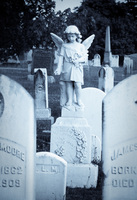 | Back to e-WV
| Back to e-WV
 The West Virginia Encyclopedia
The West Virginia Encyclopedia
 | Back to e-WV
| Back to e-WV
 The West Virginia Encyclopedia
The West Virginia Encyclopedia

The bodies of the earliest settlers were buried wherever and whenever needed, often with little ceremony and sometimes under duress. Graves were often unmarked or poorly marked, perhaps even disguised because of possible Indian desecration. Regular burial customs were established as the settlements matured.
The earliest burial containers were hollowed-out logs, followed by simple coffins made at home or by a local craftsman. Coffins were often constructed ahead of time, but graves were not dug until just before the burying. Graves were commonly dug by volunteers, especially in the family graveyards and country church yards that dot the West Virginia countryside. This custom still survives in rural areas, long after commercial undertakers have taken over other parts of the burial ritual. In early times, men built the coffin and dug the grave. Women washed and clothed the body, lined the coffin, cleaned the home, and prepared food for the wake. Planks, tables, or even ironing boards were used as cooling boards.
Wakes were common, during which family and neighbors sat with the body until the burial. Care was taken to ward off bugs and rats and cats, the latter believed capable of stealing the soul of the dead. Early hours of the wake were typified by the wailing and weeping of attending females. After cameras were available, photos were taken of the deceased lying in the coffin, often surrounded by family members. Although Irish families provided their dead with loose-fitting shrouds, most mountain people were buried in their own best clothing.
In warm weather, camphor was used plentifully as a preservative and deodorant. Weights of various kinds were placed on the corpse to keep it from swelling, and eyelids were commonly weighted with coins. Burial took place as soon as possible, especially in summer. During the winter the corpse might be kept in a homemade coffin in a barn or other outbuilding until the ground thawed. Often bodies were buried but the funeral postponed until later, when a minister was available. Because many preachers traveled extensive territories, ‘‘funeralizing’’ might be held only once a year, preferably on Memorial Day and often in the graveyard rather than the church. The service or ‘‘sarvis’’ tree was so named because its blooms appeared in late spring, in time to decorate these funeral services.
Wealthy families sent out black-edged invitations to the wake and funeral. Mourning or prayer cards, still in fashion in many parts of rural Appalachia, were distributed at the wake or the funeral. These cards often included a photo of the deceased along with favorite quotations or verses of Scripture. Mourning jewelry, such as a locket enclosing photos or a lock of hair, might be worn by family members and close friends. Hair albums and graveyard quilts were not uncommon and are still prepared by traditionalists.
Modern interpretations of old traditions may be found in such practices as newspaper memorial photos and verbal tributes. Family cemeteries may be seen in countless West Virginia locations, many of them still used for burials. Others have fallen into disuse as families have separated and land has changed ownership. Traditional customs have been replaced piecemeal, as modern funeral directors have taken over more and more of the old rituals. By the middle of the 20th century, corpses were commonly prepared for burial at the funeral home but they were still returned to the family home for a traditional wake. By century’s end, short ‘‘visitations’’ at funeral parlors had replaced wakes and the funeral was held there or at a church, as burial rituals became increasingly abbreviated and impersonal.
Written by Barbara Smith
Crissman, James K. Death and Dying in Central Appalachia. Urbana: University of Illinois Press, 1994.
Stannard, David E., ed. Death in America. Philadelphia: University of Pennsylvania Press, 1975.